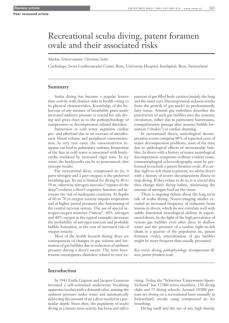Scientific papers 2000 - 2002

Abstract:
The risk of decompression sickness is a safety problem
related to offshore diving operations. Modem safety
management defines a systematic approach to such a
problem based on policy edition, support from an
organisation, planning and implementing, monitoring,
reviewing, and auditing. These activities are analysed in
light of the experience of a large diving company,
achievements are listed, and areas of improvement are
identfied. It is shown that the next edition of
decompression procedures will require hundreds of
thousands of dive records to identify the critical factors,
define models, and validate new procedures. This exceeds
the experience of a single diving company or even a
single nation, and it is believed that efforts of
decompression sickness management should be
coordinated at a European level.
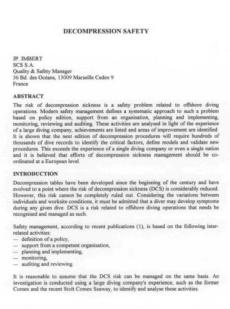

This document is a presentation of a diving algorithm
based on the Reduced Gradient Bubble Model (RGBM).
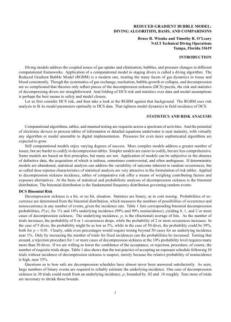

This document is written in French by doctors from the
hospital group of reunion island. It discusses herniated
intervertebral disks and diving activities.
The authors recall basic spinal hygiene rules, expose
several neuro-radiological and therapeutic indications,
and make a brief review of the literature on the impacts of
diving on the spine. The differential diagnosis with a
decompression accident in the spinal cord is also
discussed.


The oxygen window. Inherent unsaturation. Partial
pressure vacancy. Most divers with an interest in
decompression diving have likely encountered one of
these terms at some time. All three terms are used to
describe the same physical phenomenon. For this article,
the term oxygen window will be used, as it appears to be
the most commonly applied term. However, the terms
inherent unsaturation and partial pressure vacancy more
correctly describe the physical phenomenon. Current
techniques of oxygen-facilitated decompression diving are
based on use of the oxygen window.
Despite common use by divers of the oxygen window, it
appears to be one of the least appreciated concepts in
decompression diving. Understanding the oxygen
window requires knowledge of circulatory and gas
transport physiology, and the best place to start is with
normobaric physiology.


Cerebral gas embolism is a serious consequence of diving.
It is associated with decompression sickness and is
assumed to cause severe neurological dysfunction. A
mathematical model previously developed to calculate
embolism absorption time based on in vivo bubble
geometry is used in which various conditions of
hyperbaric therapy are considered… To continue…
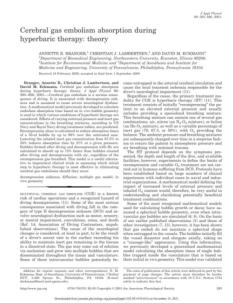

Deep stops usually reduce overall decompression time
(hang time). And when coupled to the use of helium in
the breathing mixture (trimix) to reduce narcotic effects of
nitrogen, technical divers report feeling much better
physically today when they leave the water. The
reduction in hang time ranges from 10% to as high as
50%, depending on the diver, mix, depth, and exposure
time. Feeling better while decompressing for shorter
periods of time is certainly a win-win situation that would
have been thought an impossibility not too long ago.


Physical readiness and body makeup are considered
fundamental attributes of U.S. Navy divers. Methods to
objectively determine body makeup are fraught with
shortcomings and can be technically challenging,
particularly in field operations.
Two potential field methods of determining body
composition, densitometry and deuterium oxide dilution,
were assessed and compared in the laboratory.

Authors:
R.G. Dunford, R.D. Vann , W.A. Gerth, C.F. Pieper, K.
Huggins, C. Wacholtz, and P.B. Bennett.
Decompression sickness (DCS) is a pathological event
thought caused by intravascular and extravascular gas
bubbles. The bubble theory of DCS is supported by
empirical evidence, and venous gas emboli (VGE) can be
detected after diving using non-invasive Doppler
ultrasonic methods, but the etiology of DCS is complex,
and VGE are frequent after symptom-free dives. High VGE
levels, however, are associated statistically with increased
DCS incidence suggesting that VGE and DCS may share a
common origin. Further, VGE might initiate DCS should
they cross or bypass the pulmonary capillary filter and be
transported by the arterial circulation to organs such as
the brain or spinal cord.
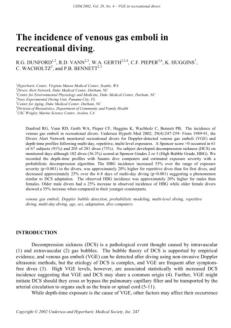

Du 6 au 10 juin 1988 eut lieu à Kongsvoll, en Norvège, un
symposium international consacré au thème de la
sursaturation et la formation de bulles dans les fluides
et les organismes.
La première partie du document présentent les
participants et le thème qu’ils ont développés. ).
La deuxième partie du document est la traduction d’un
article du Dr Hennessy qui présente une hypothèse
concernant la décompression en plongée. A la suite de
cet article, figure la retranscription de la discussion qui
suivit entre les participants à propos de cette nouvelle
hypothèse.
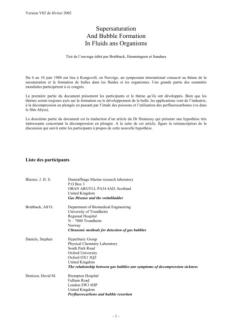


Cells from virtually all organisms respond to various
stresses by the rapid synthesis of a highly conserved set of
polypeptides termed heat shock proteins (HSPs). The
precise functions of HSPs are unknown, but there is
considerable evidence that these stress proteins are
essential for survival at both average and elevated
temperatures. HSPs also appear to play a critical role in
developing thermotolerance and protection from cellular
damage associated with stresses such as ischemia,
cytokines, and energy depletion. These observations
suggest that HSPs play an essential role in normal cellular
homeostasis and the stress response. This mini-review
examines recent evidence and hypotheses suggesting
that the HSPs may be important modifying factors in
cellular responses to various physiologically relevant
conditions such as hyperthermia, exercise, oxidative stress,
metabolic challenge, and aging.
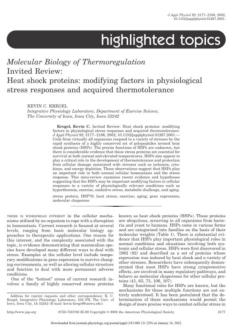

It is accepted that gas bubbles grow from pre-existing gas
nuclei in tissue. The possibility of eliminating gas nuclei
may be of benefit in preventing decompression sickness.
The present study examined the hypothesis that
hyperbaric oxygen may replace the resident gas in the
nuclei with oxygen and eliminate the nuclei themselves
because of its metabolic role.






There is a dispute as to whether paradoxical gas embolism
is an important aetiological factor in neurological
decompression illness, particularly when the spinal cord is
affected. The authors performed a blind case-controlled
study to determine the relationship between
manifestations of neurological decompression illness and
causes in 100 consecutive divers with neurological
decompression illness and 123 unaffected historical
control divers. The clinical effects of neurological
decompression illness (including the sites of lesions and
onset latency) were correlated with right-to-left shunts,
lung disease, and a provocative dive profile.
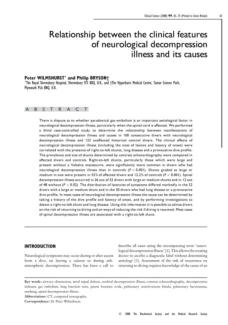

Authors: A. Hjelde, s. Kotengz, 0. Eftedalz, at A. 0. Brubakk
There is a considerable difference in detected venous gas
emboli (VGE) between individuals following
decompression. This study explores the role surface
tension that may play in the differences. The authors
measured serum surface tension in 26 anesthetized pigs
before (predive) and after a dive (postdive) to 300 kPa for
3 hours. Gas bubbles in the pulmonary artery were
monitored continuously from the beginning of
decompression and continued throughout 120 minutes
after the dive.
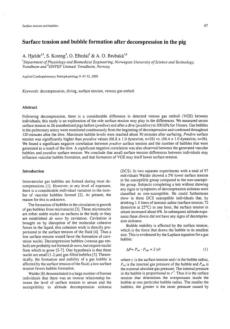

Authors: P. T. Wilmshurst, M. J. Pearson, K. P. Walsh, W. L.
Morrison, and P. Bryson.
A large right-to-left shunt is associated with neurological
decompression illness after non-provocative dives,
resulting from paradoxical gas embolism. A few
observations suggest that cutaneous decompression
illness is also associated with a right-to-left shunt, although
an embolic aetiology of a diffuse rash is more diffcult to
explain. The authors performed a retrospective case-
control comparison of the prevalence and sizes of right-to-
left shunts determined by contrast echocardiography
performed blind to history in 60 divers and one caisson
worker with a history of cutaneous decompression illness
and 123 historical control divers.
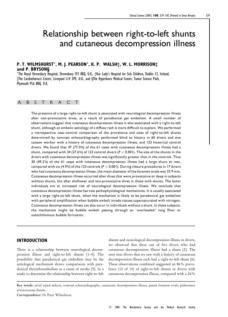

Authors: Carturan, D., A. Boussuges, P. Vanuxem, A. Bar-
Hen, H. Burnet, and B. Gardette.
This study aimed to assess the effects of ascent rate, age,
maximal oxygen uptake (VO2 max), and percent body fat
on the production of bubbles after diving. Fifty male
recreational divers performed two dives at 35 m during 25
min and then ascended in one case at 9 m/min and in
the other case at 17 m/min.
They performed the same decompression stops in the two
cases. Twenty-eight divers were Doppler monitored at 10-
min intervals until 60 min after surfacing, and the data
were analyzed by Wilcoxonsigned-rank test to compare
the effect of ascent rate on the kinetics of bubbles.
Twenty-two divers were monitored 60 min after surfacing.
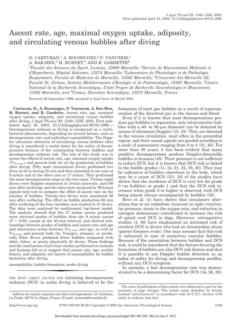

Authors: Ulrik Wisløff , Russell S. Richardson, and Alf O.
Brubakk
This study determines the effect of inhibiting nitric oxide
synthase (NOS) on bubble formation in acutely exercised
and sedentary rats exposed to hyperbaric pressure.
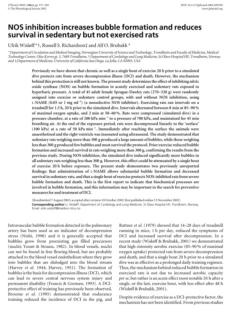

Author: Shi Zhong-yuan
A collaborative experiment with Chinese Underwater
Technology Institute, American National Office of
Research Undersea Program, and Hamilton Research Ltd.
was conducted at our Institute in Shanghai. The main
experiment objectives were to assess the longer, deeper
repetitive excursions during nitrogen-oxygen saturation
situation, oxygen exposure management, nitrox
saturation decompression after excursions and
performance aspects.
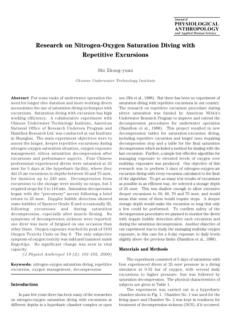

Authors: Anuj Chawla & Ak Lavania
This short paper is not a study, but a document used to
teach divers and specialists about oxyfen toxicity
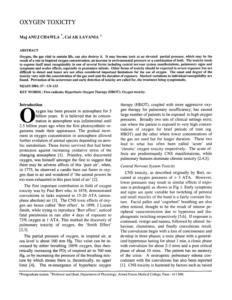

Authors: Russell P. Bowler & James D. Crapo
This document is purely medical. It has been integrated to
provide information on the effect of oxidative stress,
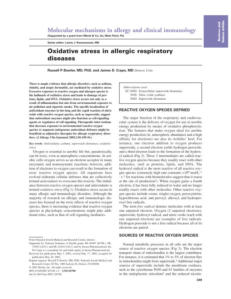


Thirteen cases of decompression sickness (DCS) occurred
during the construction of the 8-km long railway tunnel
under the Great Belt in Denmark between January 1992
and February 1996.
320 compressed air workers were subjected to 9018
pressure exposures in four tunnel boring machines.
Overall DCS incidence was 0.14%.
Working pressures ranged between 0.25 bar (1.25 atm
abs or 126.3 kPa) and 2.95 bar (3.91 atm abs or 396.3
kPa) and working times ranged between 2 minutes and
339 minutes.


Research on the validation of decompression tables is one
of common subject area of the cooperation undertaken
between the defense and civil institute of environmental
medicine, Toronto, Canada, and the Naval academy of
Gdynia - Poland
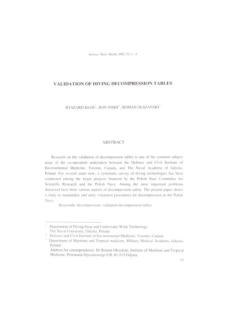

This document from Unimed Scientific Ltd, written in 2002
by Valerie Flook for “Well Ops UK Ltd”, is a theoretical
study of heliox excursion, evaluating the extent of bubble
formation and suggesting changes that would reduce
decompression bubbles. To complete the analysis quickly,
only the depths of 75 msw, 100 msw, and 130 msw have
been considered, and the maximum downward
excursions considered for each was 25, 29, and 33 msw.
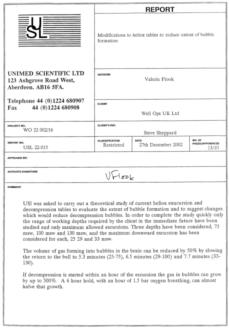

Authors: R. S. Lillo, & E. C. Parker
A mixed-gas model for rats was developed to further
explore the role of different gases in decompression and
to provide a global model for possible future evaluation of
its usefulness for human prediction. A Hill equation dose
response model was fitted to over 5,000 rat dives by using
the technique of maximum likelihood. These dives used
various mixtures of He, N 2 , Ar, and O2 and had times at
depth up to 2 h and varied decompression profiles.
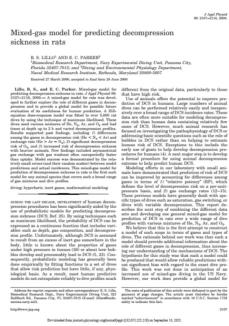

Publisher: Divers Alert Network (DAN), Durham
This document is the proceedings of a nitrox workshop
organized by the Diver Alert Network (DAN) in
November 2000.
DAN is a non-profit organization associated with Duke
University Medical Center in Durham, North Carolina,
USA. The organization operates as a lifeline for
scuba/recreational divers with a 24 hours hotline. It is
registered in our website (see in “Entertainment”)


Authors: Z. Nachum, A. Shupak, O. Spitzer, Z. Sharoni, Y.
Ramon, A. Abramovich, I. Doweck, C.R. Gordon
Inner ear decompression sickness (IEDCS) may result in
permanent, severe cochleo-vestibular deficits, unless
immediate diagnosis is reached and the correct treatment
is commenced early. Previously reported IEDCS cases
were mostly associated with deep mixed helium diving,
whereas after sport air diving this entity is considered to
be rare.


Authors: Frederick W. Rudge
This document, explains that decompression sickness may
occur during flights due to the problems posed by the
pressurization of airplane cabins. It is initially written for
aviation personels. However, it should be considered to
understand the guidelines DMAC 7.


Authors: A Onoo, M Kiyosawa, H Takase, Y Mano
Pneumatic caisson engineering has been developed for
large civil engineering constructions. Because of
complaints of blurred vision by personnel working in
pneumatic caissons, the development of myopia was
suspected. The aim of this study was to determine the
cause of the blurred vision and the mechanism
underlying the changes.
12 caisson workers underwent a complete
ophthalmological examination after completing up to 11
weeks of work (4 days/week) in a pneumatic caisson. Six
months later, nine of the workers were examined again.
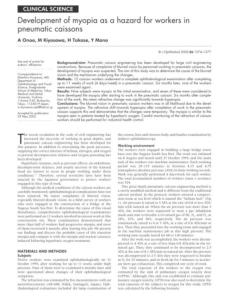

Authors: O. Hyldegaard, D. Kerem, Y. Melamed
This document discusses the resolution of micro air
bubbles injected into adipose tissue, spinal white matter,
muscle, and tendon of anesthetized rats recompressed to
and held at 284 kPa while rats breathed air, oxygen,
heliox 80:20, or heliox 50:50.
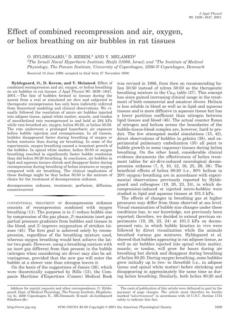

Authors: S.E. Mawle and C.A. Jackson
A sample of 142 divers, including technical divers,
recreational divers, and instructors, were examined via
questionnaire to determine the prevalence of ear
barotrauma, related barotrauma symptoms, and middle
ear infections. Sixty-four percent of divers reported
symptoms of barotrauma, which included pain (47.9%),
temporary deafness with tinnitus (27.5%) and vertigo
(9.9%). The prevalence of middle ear infection was found
in over a third of the total sample (37.3%), and was
significantly more prevalent in the left ear than in the right
ear (P=.016).
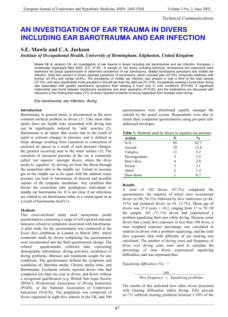

Click on the octopus
to return to the top
of the page



Authors: David M. Domsky, Charles B. Toner, Shalini
Survanshi, Andreas Fahlman, Erich Parker, & Paul
Weathersby
The authors developed a model to investigate severe
decompression sickness (DCS) from rapid ascents in deep
water. They used neutered Yorkshire pigs, exposing them
to depths of 50-150 feet and surfacing them after 22
hours of exposure. Out of 128 pigs, 78 suffered severe
DCS; 42 of 51 with cardiopulmonary complications died
within an hour. Most neurological symptoms in survivors
resolved within a day without any intervention.
This study provides insights into the impact of severe DCS
and treatment options, suggesting a need to reassess
current human models.
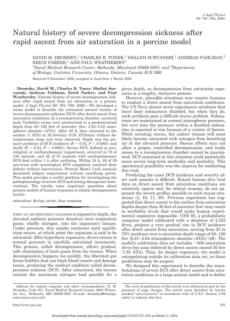

Publisher: University College London
https://www.ucl.ac.uk
Bioimpedance explores the electrical characteristics of
biological tissues, which are assessed by passing a current
through them. This impedance not only varies across
different types of tissues but also changes with frequency
and is highly sensitive to the specific histology involved.
This document offers a concise overview of the
fundamental principles associated with bioimpedance.
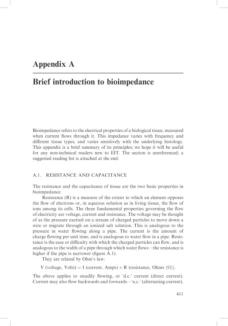

Authors: VM Lee, and AE Hay
The conclusions of this paper should be linked to post-
diving travel procedures, such as DMAC 7.
Typically, UK military aircrew are not exposed to altitudes
above 18,000 feet, but certain situations, such as cabin
depressurization or parachute operations, may require
higher exposure. Experiments assessed the risk of venous
gas embolism (VGE) and decompression illness (DCI)
symptoms up to 35,000 ft. The results show that VGE
formation is likely in aircraft, although only 7% of the
subjects exhibited symptoms.


Authors: Andreas Fahlman, Peter Tikuisis, Jeffrey F. Hlimm,
Paul K. Weathersby, & Susan R. Kayar
A probabilistic model has been developed to predict
decompression sickness (DCS) in pigs exposed to
hyperbaric hydrogen. This model helps quantify the
impact of hydrogen biochemical decompression, where
the metabolism of hydrogen by intestinal microbes aids in
safer decompression processes. The model integrates a
hypothesis that predicts the positive effects of biochemical
decompression across various compression and
decompression scenarios involving pigs in hyperbaric
hydrogen environments. This physiological interpretation
lays the groundwork for future research in this area.
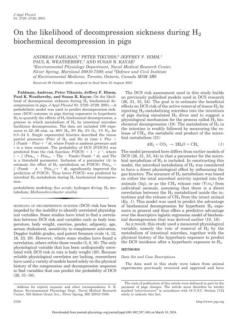

Authors: John D. Kalbfleisch and Ross L. Prentice
This paper is an invaluable asset for researchers,
statisticians, and enthusiasts in the field of statistical
analysis. It encompasses both parametric and
nonparametric approaches to failure time data. Parametric
models assume that the data adheres to a specific
distribution, necessitating the estimation of one or more
parameters from the data. In contrast, nonparametric
methods operate with minimal assumptions about the
underlying distribution, thus avoiding the need to specify
a particular distribution.
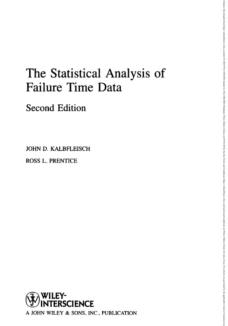

Authors: R.S. Lillo, J.F. Himm, P.K. Weathersby, D.J. Temple,
K.A. Gault, & D.M. Dromsky
To improve the prediction of decompression sickness risk
for rescuing personnel from disabled submarines, the US
Navy utilized Hill equation dose-response models. These
models were applied to 898 air-saturation, direct-ascent
dives involving humans, pigs, and rats, improving
prediction accuracy by integrating animal data. This
approach allowed for a more precise estimation of the Hill
equation exponent, enhancing the reliability of predictions
for human risk.
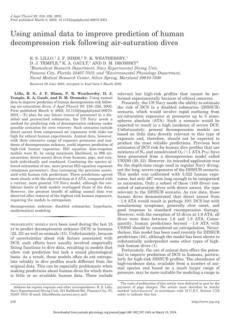

Authors: DJ Doolette, DF Gorman
This study aimed to assess occupational diving practices in
relation to established decompression models and to
outline a method for gathering and analyzing self-
reported field decompression data. The authors collected
depth and time profiles using recorders worn by
occupational divers at a tuna farm. The health status of
the divers was evaluated daily through a self-administered
health survey, which generated an interval diver health
score (DHS) ranging from 0 to 30. These depth and time
profiles were examined based on existing decompression
models.
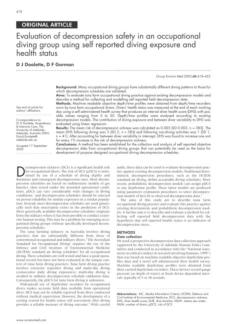



Authors: Kwangwook Cho, A. Ennaceur, Jon C. Cole, &
Chang Kook Suh
Traveling across time zones disrupts circadian rhythms
and social schedules due to time shifts. The body's internal
clock adapts slowly, causing a temporary misalignment
with external time cues, which can negatively impact
health. A study comparing airline cabin crew with ground
crew found that cabin crew had higher levels of salivary
cortisol, a marker of circadian disruption, on working days.
This was observed only during transmeridian flights, not
domestic ones. Additionally, cabin crew showed cognitive
deficits, particularly in working memory, after years of
chronic circadian rhythm disruption.
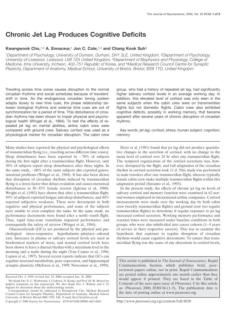

Authors: Ikram M. Elayam, Milton J. Axley, Paruchuri V.
Prasad, Stephen T. Ahlers, & Charles R. Auker
The study examines the impact of hyperbaric oxygen
(HBO) treatment on nitric oxide (NO) and oxygen free
radicals in the rat brain. Male rats were exposed to 100%
oxygen at 3 atm pressure for 2 hours. The study
concluded that NO production by NOS increases four- to
five fold under HBO conditions, suggesting that elevated
NO levels may contribute to HBO's neurotoxic effects.


Authors: Daniel K. Mulkey, Richard A. Henderson III, James
E. Olson, Robert W. Putnam, and Jay B. Dean
The study investigates oxygen levels in rat brain stem slices
exposed to normobaric hyperoxia and hyperbaric oxygen
(HBO2). They found that under control conditions with
95% oxygen at 1 atmosphere, the PO2 at the center of
the slices was significantly higher than in the intact central
nervous system. During HBO2, PO2 levels increased
further, and tissue oxygen consumption decreased at
high PO2 levels, similar to metabolically poisoned slices.
The study concludes that the control medium used in
most brain slice studies is hyperoxic at normobaric
pressure, and HBO2 reduces metabolism by increasing
PO2 levels.
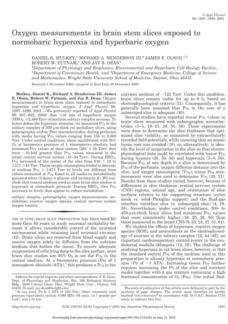

Authors: Igor B. Mekjavic, Frank St. C. Golden, C. M. Eglin
and Michael J. Tipton
This study monitored the thermal status of 30 experienced
saturation divers during routine deep dives from 54 to
160 meters, with durations ranging from 31 minutes to
7.5 hours. Divers ingested a radio pill, wore a data logger
to measure core temperature, and provided subjective
ratings of thermal perception and comfort. Results
showed a significant increase in core temperature by 0.82
°C during dives, with divers feeling thermally neutral
before and slightly warm during dives. The use of hot
water suits was effective in preventing core temperature
cooling and hypothermia.
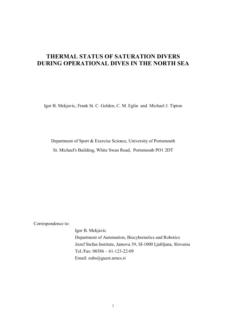

Authors: Arvid Hope, Leif Aanderud, & Asbjorn Aakvaag
This study examines dehydration and body fluid-
regulating hormones during sweating in warm (38°C)
freshwater and seawater immersion. It was found that
body weight reductions were greater in seawater (2.5 kg)
compared to freshwater (1.9 kg) during 4-hour head-out
immersion experiments. Additionally, the effects of
temperature on fluid loss were analyzed, showing
negligible sweat production in thermoneutral (34.5°C)
seawater compared to significant sweat production in
warm seawater. The study recommends mandatory
breaks for fluid intake during dives lasting more than 4
hours to prevent dehydration.
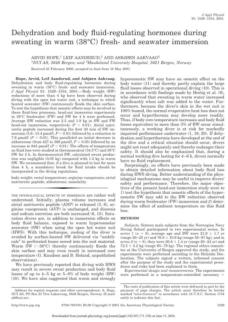

Authors:
Hidetoshi Nagashima, Kazuya Matsumoto, Yoojin Seo,
Motohiko Mohri, Nobuo Naraki, and Shigeaki Matsuoka
This study examined sleep patterns during saturation dives
at a 30-meter depth and habitation in a confined
environment at 1 atm absolute pressure to evaluate the
effects of environmental pressure. Eight inexperienced
divers and nine healthy subjects participated, with sleep
data recorded over 262 nights. Both conditions showed
reductions in total sleep time, increased sleep latency, and
decreased sleep efficiency, suggesting that these changes
were due to psychological and physiological stresses from
prolonged stays in a confined environment rather than
the environmental pressure itself.
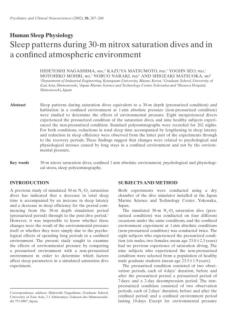

Authors: Thomas Heitzer, Titus Schlinzig, Karoline Krohn,
Thomas Meinertz, Thomas Münzel
This study investigates the relationship between
endothelial dysfunction, vascular oxidative stress, and
cardiovascular event rates in coronary artery disease
(CAD) patients. It highlights that impaired endothelial
function and increased oxidative stress are linked to
atherosclerosis and may contribute to cardiovascular
events. It suggests that both endothelial dysfunction and
heightened oxidative stress are predictors of
cardiovascular events in CAD patients, supporting the idea
that oxidative stress plays a significant role in endothelial
dysfunction and coronary artery disease progression.
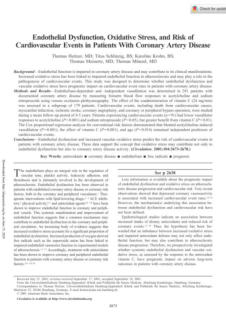

Authors: Vibeke Nossum, Atrid Hjelde, Alf O Brubakk
This study investigated the effects of gas bubbles from
decompression and gas embolization on endothelial
function and mechanical injury in rabbits. Twelve rabbits
received an infusion of 0.01 ml air/min/kg via a jugular
vein catheter for 60 minutes. The endothelial response
was assessed by measuring tension in the blood vessel
walls and morphological changes by light microscopy.
The study concludes that even small amounts of gas
bubbles, similar to "silent bubbles", can impair
endothelium-dependent vasoactive responses.
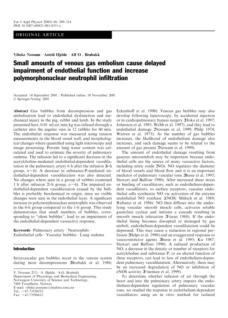

Author: Wulf Droge
This document describes free radicals and reactive oxygen
species (ROS), which can be harmful at high
concentrations, damaging cellular components. However,
they play crucial roles at moderate levels in cell signaling
and regulatory processes, such as maintaining redox
homeostasis, regulating vascular tone, and controlling
oxygen tension.


Authors: Steffen Skogland, Kare Segadal, Harald Sundland,
& Arvid Hope
This study investigates the effects of pressure reduction,
decompression rate, and repeated exposure to venous
gas bubble formation in rats exposed to a heliox
atmosphere. Five groups of conscious, freely moving rats
were exposed to different pressure levels and
decompression steps. The results showed that a larger
decompression step resulted in significantly more bubbles
at the same rate. Faster decompression rates also resulted
in more bubbles. There was no significant difference in
bubble formation between the first and second
exposures.
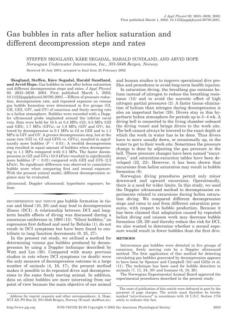

Authors:
Keith T. Palmer, Jason Poole, Jon G. Ayres, Jonathan
Mann, P. Sherwood Burge, and David Coggon
The authors conducted a case-control study involving
men aged 20–64 admitted to hospitals in the West
Midlands, England, with community-acquired pneumonia
from 1996 to 1999 to test whether inhalation of metal
fumes increases susceptibility to pneumonia. The study
found that recent occupational exposure to metal fumes,
particularly ferrous fumes, was associated with an
increased risk of pneumonia.


Authors: M El-Zein, J-L Malo, C Infante-Rivard, D Gautrin
The study aimed to determine the prevalence of
coexisting welding-related systemic symptoms indicative
of metal fume fever (MFF) and respiratory symptoms
suggestive of occupational asthma (OA) among welders.
Researchers administered questionnaires on respiratory
and systemic symptoms, as well as occupational history, to
351 welders. The findings revealed a strong association
between MFF and respiratory symptoms indicative of OA,
suggesting that MFF could be a pre-marker for welding-
related OA. Further investigation is needed to confirm this
hypothesis.
.
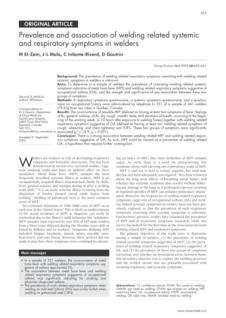

Authors: Kevin K. McCully, and Takafumi Hamaoka
This document highlights that the measurement of
oxygen is important for muscle studies and that near-
infrared spectroscopy (NIRS) has numerous significant
advantages compared to other noninvasive methods,
such as plethysmography and Doppler imaging, that
provide global flow measures but do not show actual
oxygen delivery. Among the advantages described in this
text, we can mention its portability, low cost, and ability to
detect the balance between oxygen delivery and
utilization.
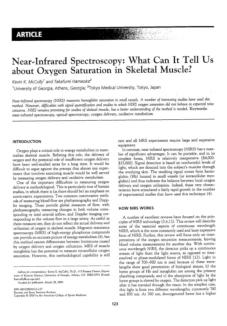

Author: Barbara Shykoff
This study aimed to check the effects of air and oxygen on
pulmonary function during a dive. For this aim, the
authors examined the variability of Pulmonary Function
Tests (PFTs) of 21 volunteers over six weeks without
engaging in diving activities and analyzed the effects of
different oxygen partial pressures (PO2) on 24 divers
following dives lasting four, six, and eight hours to a depth
of 15 feet in fresh water. They conclude that a 4-hour
underwater exposure to PO2 of 1.4 ATA is not worse than
one with PO2 of 0.3 ATA but that air-breathing
underwater is associated with some pulmonary injury.



7 - A mathematical model of diffusion-limited gas bubble dynamics
in tissue with varying diffusion region thickness.


Authors: R. Srini Srinivasan, Wayne A. Gerth, Michael R.
Powell
The three-region model of gas bubble dynamics includes
a bubble, a stirred tissue area, and an unperfused
diffusion region. This model was used to assume the
diffusion region had a constant thickness and uniform
gas diffusivity, leading to unchanged gas content as the
bubble grew, which violated Henry’s law. The new work
corrects this by suggesting different gas diffusivity at the
bubble surface and the diffusion region, allowing
changes in thickness and gas content during bubble
growth. This corrected model can produce longer
bubble lifetimes, addressing the need for simple yet
consistent models in studying decompression sickness in
humans

Authors: Valerie Flook, Ronald Nishi, Aaron Khan
This paper discusses the best treatment for dysbarism after
a serious decompression accident while using self-
contained breathing gear like the Canadian Underwater
Minecountermeasures Apparatus (CUMA) at 81 meters
depth. It includes a theoretical analysis and experimental
work to explore specific issues from the analysis.

13 - Modelling and Validation of Treatment Tables for Severe
Decompression Accidents

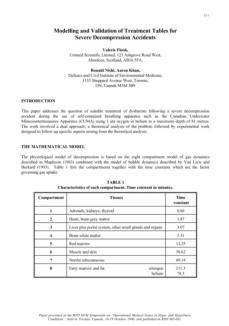



15 - Insights on Deep Bounce Dive Safety From the Technical Diving
community.
Author: Richard L. Pyle
Over the past fifteen years, recreational divers have
advanced techniques and equipment in "Technical
Diving," focusing on deep dives using multiple gas mixes
to depths of 60-150 meters. Collectively, they’ve noted
trends that may inform hyperbaric research. They have
developed specific decompression strategies, including
deep stops and slow ascents, to combat decompression
sickness. The Technical Diving community has also
adopted In-Water Recompression (IWR) and observed
unusual physiological symptoms, suggesting a need for
collaboration with hyperbaric researchers.
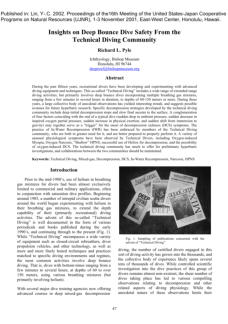

Author: Ryszard KLlos, Ron Nishi, Roman Olszanski
Research on the validation of decompression tables is
important for the cotton subject areas between the
Centre and Civil Institute of Environmental Medicine,
Toronto, Canada, and the Naval Academy of Gdynia,
Poland. A systematic survey of diving technologies has
been conducted among projects funded by the Polish
State Committee for Scientific Research and the Polish
Navy. Various aspects of decompression safety have been
discussed. The present paper shows a study to
standardize and unify validation procedures for
decompression in the Polish Navy.


35 - Validation of decompression tables
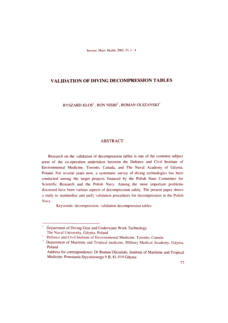



46 - Development and validation of 1.3 ata PO2-in-He
Decompression tables for the MK 16 Mod 1 UBA.
Authors: Wayne A. Gerth, Thomas M. Johnson
The Navy Experimental Diving Unit (NEDU) was asked by
PMS-EOD to create and validate helium-oxygen (He-O2)
decompression tables for the MK 16 MOD 1 Underwater
Breathing Apparatus (UBA). This report outlines the work
done and describes the probabilistic model used, along
with a method to convert it to a simpler deterministic
model. The final product includes decompression tables
similar to those for standard air diving but with controlled
estimated DCS risks.




24 - Recreational scuba diving, patent foramen ovale and their
associated risks

Authors: Markus Schwerzmann, Christian Seiler
Scuba diving presents various health risks linked to gas
behaviors under pressure and physiological changes.
Immersion in cold water can increase cardiac load,
sometimes leading to pulmonary edema. Compressed
air, preferred for recreational diving, poses risks like
nitrogen narcosis and oxygen toxicity at greater depths.
Barotrauma and decompression sickness are significant
hazards arising from gas bubbles during ascent.
Neurological issues are common among divers, and
proper evaluations for heart shunts are crucial for those
with past decompression symptoms, highlighting the
debate over long-term diving risks
